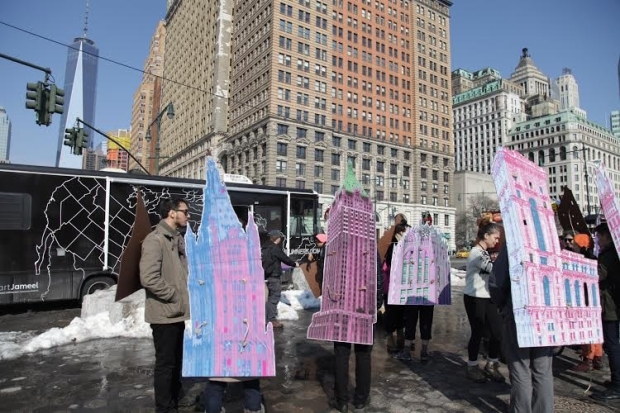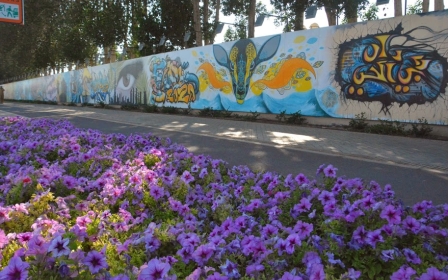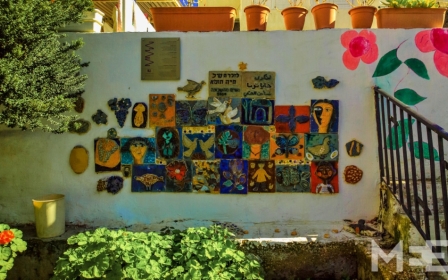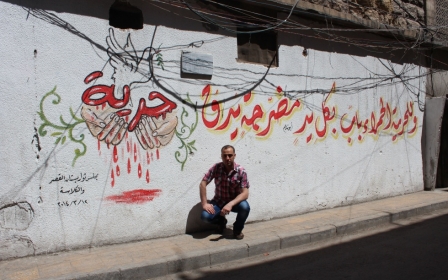Motorhome odyssey brings Arab art to US backwaters
The unlikely odyssey will see more than 100 creatives take cross-continental trips by the time it wraps up in 2017

Artists exchange views inside the nine-metre motorhome (MEE/Edge of Arabia)
Published date: 7 May 2015 22:50 BST
|
Last update: 9 years 6 months ago
NEW YORK – From the outside, it resembles the all-American road vehicles that cruise freeways from coast to coast. But inside, rich red fabrics and Arabian rugs tell a different story about life inside this nine-metre motorhome.
The six-wheeler – known by its occupants as “Gulf Stream” – has become an on-the-road home for Middle Eastern artists travelling between US art shows, universities and into the boondocks in a three-year mission to bridge East-West divisions.
So far, more than 25 artists have travelled from the Middle East to climb aboard, collaborate on artworks and meet with dealers, students and everyday Americans from the skyscrapers of New York to the backwaters of Alabama.
The unlikely odyssey is arranged by Edge of Arabia and Art Jameel. It will see more than 100 creatives take cross-continental trips by the time it wraps up in 2017.
“We wanted to connect two great centres of ideology and powerhouses of history-making: the Islamic World, centred on Saudi Arabia, and the consumer capitalism of America,” Edge of Arabia’s co-founder Stephen Stapleton told Middle East Eye (MEE).
“For us, artists are story-tellers, and this is a format that allows them to travel between each other’s worlds and bring fresh perspectives. Without this, we are saturated with conventional journalistic story-telling, with its focus on violence, religious extremism and so-called clashes of civilisation.”
One of the participants, Palestinian artist Yazan Khalili, will visit three US towns called Palestine – in Michigan, Ohio and Texas. Another, Bahrain-based artist Faisal Samra, will examine why tribesmen on the Pine Ridge Indian Reservation in South Dakota eschew state housing projects.
Visitors to the Armory Show, an annual modern art fair held in New York in March, watched in amusement at the traditionally-dressed Iranian-American artist Darvish Fakhr "gliding" on his flying carpet – a Persian rug atop a motorized skateboard.
In the other direction, US artist Matthew Mazzotta is in Jeddah, working to revive more than a dozen buildings in the coastal Saudi city’s old town – a crumbling, cosmopolitan warren of alleys, spice stalls and hookah bars that is reminiscent of the Arabian Nights saga.
Palestinian filmmaker Husam Al-Sayed, who was born and raised in Saudi, has also gained from the scheme. Back in Jeddah, he helps run the satirical online video network Telfaz11. In Manhattan, the skyline has re-kindled his creativity.
“New York is very generous for filmmakers,” the shaven-headed 30-year-old told MEE. “I’m a street photographer, I thrive on street life, and it’s challenging to do that back in Saudi Arabia. It’s my passion, and I’ve found it here.”
Once in New York, al-Sayed met Brian Zegeer and made a documentary about the American artist’s Arab roots and efforts to save the remnants of "Little Syria" – an area of lower Manhattan that was home to Levantine immigrants from the 1880s to the 1940s.
“It once spanned 10-20 blocks, now there are only three buildings. One is a church, another a Chinese takeaway. It’s a sad story, I automatically empathised with it,” he said. “It’s a Palestinian thing. I remember my family moving around and me moving around, not finding a place where we belong.”
For his part, Zegeer was exploring the history of a distant relative, the Arab-American writer Ameen Rihani, and his family’s history in the city’s once-bustling Arab district, which was ultimately demolished in the late 1940s to make way for the Brooklyn-Battery Tunnel.
Zegeer’s project culminated in March with a pageant through the leftovers of Little Syria. The motorhome parked up, and campaigners trudged through slush and snow wearing colourful banners depicting buildings from the district’s Arab heyday.
“The Little Syria project offers a positive narrative of the Middle Eastern diaspora accepting and being accepted into US culture,” Zegeer told MEE. “It is a story of rich cultural cross-pollination – a positive narrative to contrast the shallow divisiveness that is fed to us daily.”
Edge of Arabia’s organisers spend $10-15,000 on each of the artist’s projects and travel costs, with money coming from the wealthy Saudi-based Jameel family, which distributes Toyota and Lexus vehicles across the Middle East.
The nationwide motorhome tour is the latest chapter in a 12-year-old project that began in the wake of the 9/11 attacks and continued amid tensions between Islam and the West and years of war and civil strife in the Middle East.
It started in 2003, when Stapleton met Ahmed Mater, a doctor and artist who works with X-rays, magnets and iron filings, at the Al-Meftaha Arts Village in Abha, southern Saudi Arabia. They were later joined by another Saudi artist, Abdulnasser Gharem.
Motivated by a desire to promote Saudi art overseas, they held their first exhibition at the Brunei Gallery in London in 2008. They have since showcased at the Venice Biennale and in Berlin, Dubai and Istanbul.
In the US, events at the Armory Show, Columbia University, UN headquarters, the Massachusetts Institute of Technology, the Smithsonian Institution and Rothko Chapel in Houston will attract combined audiences of more than 70,000 people, Stapleton said.
But that is dwarfed by the five million viewers who will catch up via Telfaz11 and other online media channels, he added.
Stapleton has spent more than a decade promoting artists across Arabia and the West. After years of exchanging ideas between the two cultures, he is coming round to the idea that – perhaps – they are not so different after all.
During his motorhome trip through the Deep South in September, he fielded questions from locals with concerns about Islam and the Middle East that were driven by scaremongering US news channels, he said.
“But once they see our artists’ projects, they find areas of common concern. An artist from Ramallah can deal with the same problems of a small town in Louisiana,” he told MEE. “In both places, people are worried about disparities between the powerful and powerless and corporations influencing politicians and breaking communities apart.”
New MEE newsletter: Jerusalem Dispatch
Sign up to get the latest insights and analysis on Israel-Palestine, alongside Turkey Unpacked and other MEE newsletters
Middle East Eye delivers independent and unrivalled coverage and analysis of the Middle East, North Africa and beyond. To learn more about republishing this content and the associated fees, please fill out this form. More about MEE can be found here.





